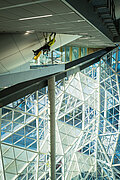Then there was sudden movement in the team. Some rushed immediately to the source of the scream, and others dropped what they were doing to bring the machine to a stop. Karl R. also dashed to the spot and dug his mobile out of his pocket. Next to the big production machine he found a group of workers surrounding two men on their knees. Between them was the motionless body of a technician in his protective equipment.
But even before he reached the group, Karl had already pressed the Dial button and reported the fall accident to the emergency operator. For the rest of the day, the managing director spent his time on damage limitation, questions of liability and legal foundations, and on a rough cost estimate which worked out very much higher than he had feared. However, he was much more disturbed by the injury to his employee, and as he passed through the clinic’s automatic door, he mentally composed suitable words for his trusty worker of many years. In this blog post, find out how matters progressed for this industrial operation in Salzburg, and why fall protection is always cheaper than a fall.
What exactly is a fall?
As it later turned out, the technician from Salzburg who suffered the accident slipped through lack of attention while performing repairs on the production machine. During this, a heavy tool fell into the machine, where it caused serious damage. The exact circumstances of the fall have yet to be clarified; it is possible that the safety harness was not worn correctly. According to BAuA: (German Federal Institute for Occupational Safety and Health), the term “fall” covers the following situations:
- falling onto a surface or object at a lower level
- breaking through a non-supporting surface
- sliding uncontrollably over a fall edge when working on inclined surfaces
According to Austrian Economic Chambers, a fall is to be considered an industrial accident if it results in certain obligations for the service recipient and for the service provider, such as reporting an accident, obligation to keep records, and assessment of events related to an accident.
What are the costs created by a fall accident?
Luckily the emergency doctor and the ambulance were on the spot immediately after the accident in the industrial hall; the technician who fell could therefore be treated quickly, and he will make a full recovery. But he is still off work for several weeks, because in addition to concussion, bruises, and abrasions, he has also broken his collar bone and wrist. This is one of several cost items which affected the Salzburg industrial operation as a result of the fall accident:
- Sickness-related absence:
The injured employee’s salary, including non-wage labour costs, must continue to be paid during his two to three month absence, even though he is unable to perform his duties.
- Replacement:
To replace the absent technician, his colleagues may work paid overtime, or the company may decide to appoint a new specialist worker. In any case, salary costs including non-wage labour costs also arise here in order to substitute the colleague who fell.
- Machine stoppage:
While the manufacturing machine is stopped, there is a loss of production for several hours or days, with costs of repair in addition. If this also results in delivery problems or compromised quality, then additional consequential costs must be expected.
- Threat of penalties:
In Austria, if assessors and courts can prove negligent conduct by the operators of the undertaking or plant due to an illusion of safety, they are liable to penalties, for example because of violation and breaches of the ASchG (employee protection), MSV (machine safety), or PSA-V (PPE) laws.
- Non-calculable costs:
Even the suspicion of negligent conduct towards one’s own employees can have disastrous consequences for a company, such as a noticeable loss of image and permanently damaged employer branding.
What are the costs caused by fall protection?
Although the lawyers of Karl R. and the installation company may well dispute this in court, and whoever is made responsible for the fall accident at the production machine, the managing director must urgently improve industrial safety. Together with his safety specialist, he revisits the subject of fall protection. One-time and recurring costs arise to the industrial operation:
One-time investment costs for real fall protection
- Planning and installation of the safety system:
Planning (possibly development of a special solution), material costs, hourly rates for fitters, own and external workers (e.g. additional structural engineer), travel expenses, documentation of the installed fall protection system (free of charge with INNO|doc).
- PPE equipment:
Personal protective equipment for all authorised employees, e.g. safety shoes, spectacles, gloves, harness, carabiners, etc.
Recurring costs for an appropriate and effective fall protection system
- Servicing costs:
Annual assessment of the fall protection system, including PPE and rescue measures, by a trained safety specialist, plus possibly repair and replacement parts.
- Prevention-related qualification measures:
Annual anti-fall PPE training, rescue training for all employees; every three years, certified training for safety specialist.
- Safety-related and industrial medical support:
User guide developed by an inspection (TÜV) and civil engineer, in order to instruct employees about the fall protection system, plus instruction in rescue measures by an internal or external safety specialist.
Return on prevention for companies: A fall protection system pays for itself
An appropriate and effective fall protection system creates costs which are to some extent recurring. However, these pay in the long term, as the DGUV report Calculation of the international “Return on Prevention” for Companies has shown. In terms of industrial health and safety protection for the companies questioned, the return on prevention shows that for each employee the annual costs of prevention amount to € 1,200.00 on average, but the benefits of prevention are € 2,645.00. This results in a prevention gain of € 1,445.00. In a current research project AUVA (Austrian Workers' Compensation Board) reaches a similar conclusion: “The evaluations have shown that on average an accident at or to/from work causes the employer a financial loss of around € 2,500.00!” What the report’s calculations prove applies to all levels of a holistic safety concept which protects workers both from a fall and in the event of a fall.
Fall protection is always cheaper than a fall, because the invested costs turn out to be less than the cost of the unforeseeable consequences. Here it is not merely the actual cost savings from the avoidance of operational disruptions, overtime, loss of production, etc., thanks to real fall protection. Rather it is also the company's growth in value because of an improved image, satisfied and productive employees, sustained quality orientation, and a strong corporate brand. On the other hand, following a fall accident, the responsible persons of an industrial operation are brought to court because of negligence, and the effects of this represent a threat to existence which must be taken seriously.
Summary: Fall protection is always cheaper than a fall
As Karl R. sits at his technician’s hospital bed, just a few hours after the fall from a height of 5 metres, he looks into a wan but forgiving face. “We really screwed up there, boss.” “I know. That won’t happen again.” The managing director’s eyes follow his loyal employee being wheeled down to the operating theatre. The boss leaves the room with a feeling of guilt mixed with relief.
Would you like to find out more about sustainable safety concepts in industrial operations? Then download our manual about fall protection in industry now, free of charge.














